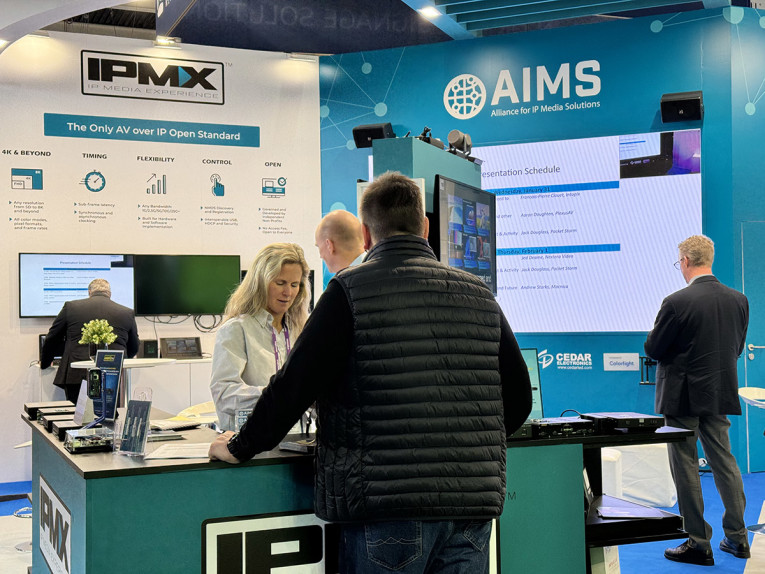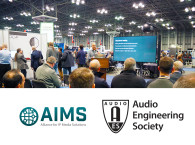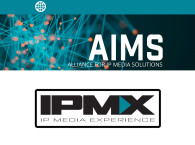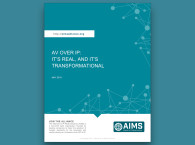
The Alliance for IP Media Solutions (AIMS) continues to promote the increasing adoption of the Internet Protocol Media Experience (IPMX) set of open standards-based protocols designed to ensure interoperability for AV-over-IP systems. At the ISE 2024 show visitors to the AIMS-IPMX booth could see a series of demonstrations of IPMX-based hardware and software working together, with presentations highlighting the standard's development and adoption. For ISE 2024, AIMS provided demonstrations of IPMX interoperability in multivendor digital signage systems featuring HDCP content, an HDR application, and even an interesting NDI/IPMX gateway, recognizing the fact that the Newtek-originated NDI technology is another networking de facto standard.
Created by AIMS in collaboration with the Video Services Forum (VSF) and the Advanced Media Workflow Association (AMWA), the IPMX efforts are intended to implement a standards-based approach based on SMPTE ST 2110, with features and capabilities that target the specific needs of the broadcast and Pro AV industries. In addition to simplifying the implementation of SMPTE ST 2110 and ensuring interoperability for AV-over-IP systems, IPMX incorporates core features tailored to Pro AV installations. These features include asynchronous audio and video support suitable for both live production and Pro AV presentations, 4K60 transmission over a single gigabit network, and HDCP for content security. IPMX also includes a control layer, provided by AMWA's NMOS specifications, which enhances device interoperability and eases the dependency on a myriad of proprietary control system protocols.
"Historically, the broadcast and Pro AV industries have operated independently, with Pro AV lacking the uniform standards prevalent in the broadcast industry. In addition, the need to enable a convergence between live production and presentation systems within the two industries has become increasingly apparent. IPMX was created to address both of these issues and has made great strides over the last year," says Andrew Starks, board of directors member and marketing working group chair for AIMS. "The standard is set to really take off in 2024."

Final Standards Documents
Effectively, ISE 2024 signaled a significant milestone in the development of the Internet Protocol Media Experience (IPMX) standards. Prior to the Barcelona event, the Video Services Forum (VSF) concluded a rigorous testing event held at the Matrox Video facility in Munich, where multiple manufacturers with IPMX implementations validated core specifications.
This event marked the transition of many of the essential IPMX documents — encompassing critical aspects of audio and video transport, HDCP, control plane requirements, and system timing — from draft to finalized specifications. This pivotal step not only underscores the robust, collaborative effort behind IPMX but also signals a new era of innovation and interoperability in the Pro AV market.
Reflecting on the significance of this milestone, Samuel Recine, Vice-President, Global Strategic Partnerships, Matrox Video & Pro AV Working Group Chairperson for AIMS, stated: "There is no question that IPMX is gaining momentum in the Pro AV market. With these documents in their final form, IPMX can now be implemented by even more manufacturers, which is what is needed for a robust, open AV-over-IP ecosystem."
The release of several key IPMX specification includes vital documents for Uncompressed Video (TR-10-2), Constant Bit Rate (CBR) Video (TR-10-11), PCM Audio (TR-10-3), System Timing and Definitions (TR-10-1), HDCP Key Exchange Protocol (HKEP) Copy Protection (TR-10-5), and NMOS requirements specific to IPMX (TR-10-8).
Brad Gilmer, Executive Director of VSF, reflected on the path that led to this achievement: "We've been witnessing the industry trend towards more convergence, which means removing unnecessary legacy barriers between not only IT and video production, but also between broadcast and the Pro AV market. That is why we started work on IPMX immediately after AIMS launched the initiative in 2020. The release of these documents is a big milestone not only for IPMX, but also for VSF as our work to evolve to meet the needs of a more diverse and interconnected world is clearly bearing fruit."
Further work is now being promoted on key interoperability areas, such as creating a USB extension, profiles, and detailed testing requirements. AIMS and VSF, as well as the Advanced Media Workflow Association (AMWA), creators of NMOS, remain committed to this collaborative effort, with the aim of announcing additional significant developments in the near future. Anticipation is high for potential updates and breakthroughs that may align with major industry events like InfoComm 2024. These efforts underscore a continued dedication to evolving IPMX into a fully realized, open standard that meets the diverse and interconnected needs of the modern Pro AV landscape.
www.ipmx.io
www.aimsalliance.org








